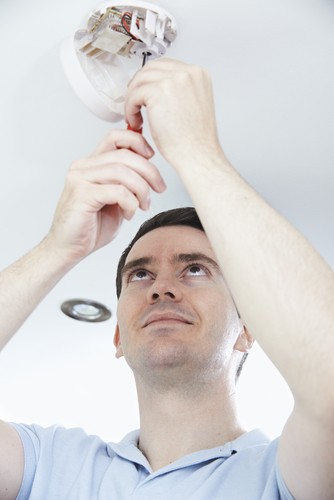
You hear tragic stories on the news about people dying from carbon monoxide poisoning or electrical shock and you think, “That will never happen to me.” But do you think they thought it would ever happen to them? No, they didn’t. The team at Fusion Electric has put together this helpful information about carbon monoxide safety to keep your family safe from these common dangers in your home that could actually kill you. Read on and make sure your home is safe,
Scary Facts about Carbon Monoxide
- On average 430 people die every year in the U.S. from accidental CO poisoning
- Carbon monoxide gas is colorless, odorless making it undetectable
- Carbon monoxide is typically vented outside of your home
- More than 20,000 Americans visit the hospital each year for suspected carbon monoxide poisoning
- Carbon monoxide can be created by stoves, generators, fireplaces, water heaters, vehicles, and furnaces
Safety Tips to Prevent Carbon Monoxide Poisoning
- Your first line of defense is to make sure you have working CO detectors installed in several areas of your home
- Make sure you test your CO alarms once a month
- Replace the batteries in your CO alarms twice a year at least
- Know what sound your CO alarm makes when it’s set off
- If your CO alarms do sound, make sure everyone inside the home gets to a place where they can get fresh air, preferably outside. Call the fire department quickly
- Never let your car idle to warm up inside of a closed space like a garage. Always move your car outside first
- During and after a snowstorm, clear the exit vents to your dryer, furnace, and stove
- Always open the damper in your fireplace for proper ventilation when in use
- Only use gas and charcoal grills outside because they produce CO gas
Shocking Facts about Electrical Accidents
According to the ESFI (Electrical Safety Foundation International), more than 30,000 non-fatal shock accidents occur each year.
- More than two hundred people die from electrocution each year
- According to the U.S. Consumer Product Safety Commission, 70 percent of child-related electrical accidents occur at home, when adult supervision is present
- Each year, there is an estimated average of 60 electrocutions associated with consumer products. The three most common product categories are
1. small appliance
2. power tool
3. lighting equipment
Electrical Safety Tips
- Faulty appliances – never use an appliance with cracked, worn, or frayed cords
- Throw out all extension cords that are damaged or frayed
- Electrical appliances – never let electrical appliances come into contact with water.
- Old wiring – replace incorrect or deteriorated household wiring
Electric outlets – if there are young children at home, it’s recommended to use outlet covers. - Swimming pools, hot tubs & spas – faulty wiring in pools and hot tubs pose the serious risk of electrocution and electric shock due to defective underwater lighting, faulty and old wiring, and improperly grounded vacuums.
GFCIs are regarded as one of the best ways to prevent electrocution. Have an electrician check to be sure you have properly working GFCIs on all outlets near water (kitchens, bathrooms, outdoor).
Related Read: 3 Reasons Your KC Home Needs an Electrical Inspection
Three Ways to Make Your Home Safe
1. Early Education about the Dangers of Electricity
One of the biggest ways to protect children from being electrocuted is by teaching them about safe electrical practices. This should start when a child is a toddler. Parents should continue electrical safety education during family safety drills while children are under the age of twelve. However, annual training is not enough since children need constant reminders.
2. Preventative Maintenance for Electrical Appliances
Making sure that all cords on lamps, kitchen appliances, and other electrical items are free from wear and tear is an important part of protecting young children. Cords that are broken, damaged, show wiring, or do not work properly should be discarded.
This includes extension cords. Outlets should be replaced if they are cracked or broken. Lights and appliances with a short in them should also be replaced. They are a fire and electrical shock hazard.
3. Make Sure Your Outlets Have GFCIs for Shock Prevention
Most parents know that installing outlet covers is the most basic way to protect their children from being shocked. Another big part of childproofing a home includes upgrading kitchen, bath, and outdoor outlets to Ground Fault Circuit Interrupters (GFCI’s).
GFCIs prevent shock or electrocution if an appliance comes in contact with water (or any time it senses a surge in electricity). The GFCI measures the amount of current flowing from hot to neutral, so when there is imbalance, the circuit trips. Normally a GFCI can detect variations as small as 4 milliamps, and it trips quickly cutting off electricity.
How to Test a GFCI
To test your ground fault circuit interrupter (GFCI), plug in a light or other device into the outlet then just press the test button in. You will hear a snap sound that trips the outlet and cuts power off to the two plug in connections. If the light goes out, you’ll know the outlets don’t work and the safety mechanism performed correctly. Once you know the GFCI is functioning properly, press the reset button and the outlet should once again be on.
The U.S. government recommends that GFCI’s should be inspected after every storm and once per month. They also say that more than twenty-five percent of people in the country do not know how helpful GFCI’s can be, and half of those that use them do not test their GFCI’s.


